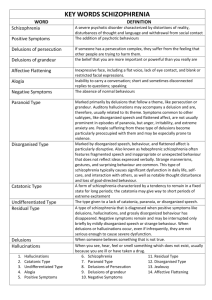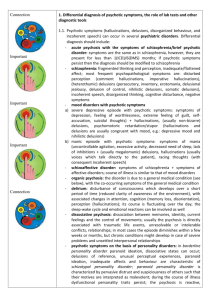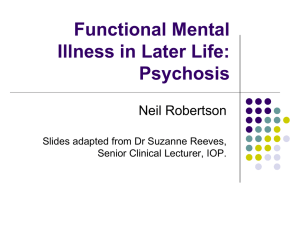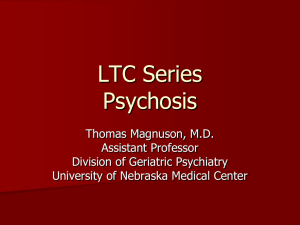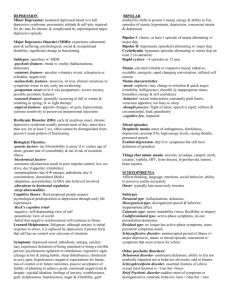CHAPTER 8: EXPERIENCING PSYCHOSIS: SCHIZOPHRENIA
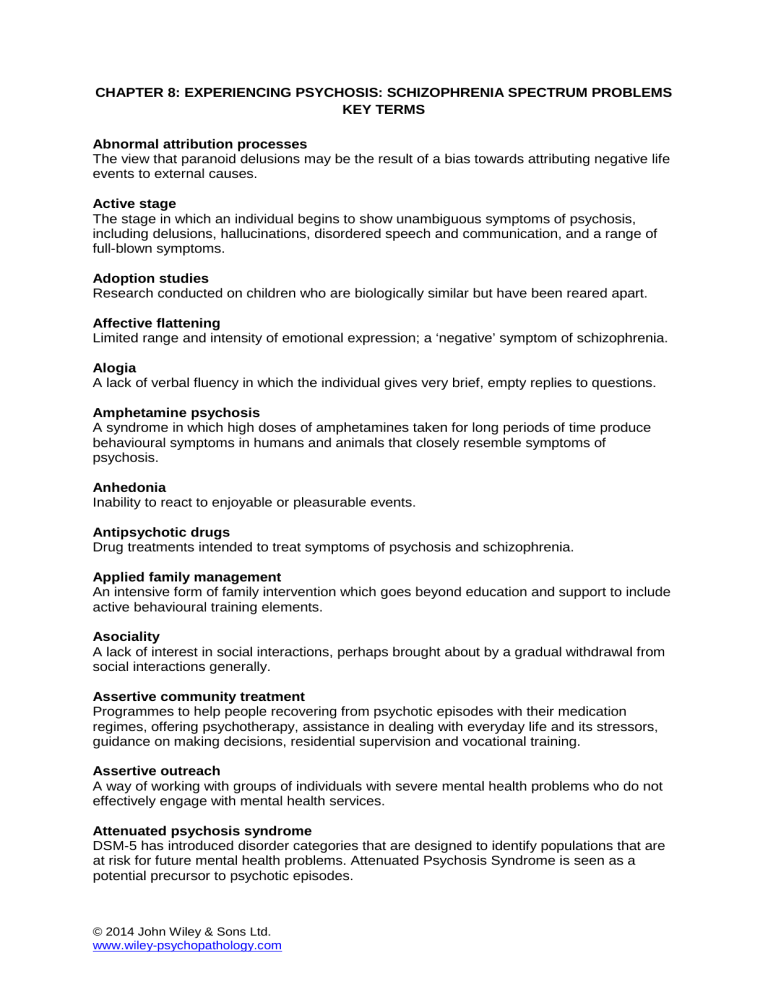
CHAPTER 8: EXPERIENCING PSYCHOSIS: SCHIZOPHRENIA SPECTRUM PROBLEMS
KEY TERMS
Abnormal attribution processes
The view that paranoid delusions may be the result of a bias towards attributing negative life events to external causes.
Active stage
The stage in which an individual begins to show unambiguous symptoms of psychosis, including delusions, hallucinations, disordered speech and communication, and a range of full-blown symptoms.
Adoption studies
Research conducted on children who are biologically similar but have been reared apart.
Affective flattening
Limited range and intensity of emotional expression; a ‘negative’ symptom of schizophrenia.
Alogia
A lack of verbal fluency in which the individual gives very brief, empty replies to questions.
Amphetamine psychosis
A syndrome in which high doses of amphetamines taken for long periods of time produce behavioural symptoms in humans and animals that closely resemble symptoms of psychosis.
Anhedonia
Inability to react to enjoyable or pleasurable events.
Antipsychotic drugs
Drug treatments intended to treat symptoms of psychosis and schizophrenia.
Applied family management
An intensive form of family intervention which goes beyond education and support to include active behavioural training elements.
Asociality
A lack of interest in social interactions, perhaps brought about by a gradual withdrawal from social interactions generally.
Assertive community treatment
Programmes to help people recovering from psychotic episodes with their medication regimes, offering psychotherapy, assistance in dealing with everyday life and its stressors, guidance on making decisions, residential supervision and vocational training.
Assertive outreach
A way of working with groups of individuals with severe mental health problems who do not effectively engage with mental health services.
Attenuated psychosis syndrome
DSM-5 has introduced disorder categories that are designed to identify populations that are at risk for future mental health problems. Attenuated Psychosis Syndrome is seen as a potential precursor to psychotic episodes.
© 2014 John Wiley & Sons Ltd. www.wiley-psychopathology.com
Avolition
An inability to carry out or complete normal day-to-day goal-oriented activities, and this results in the individual showing little interest in social or work activities.
Basal ganglia
A series of structures located deep in the brain responsible for motor movements.
Brief psychotic disorder
The sudden onset of at least one of the main psychotic symptoms, with this change from a nonpsychotic state to the appearance of symptoms occurring within 2 weeks and being associated with emotional turmoil or overwhelming confusion.
Case manager
Oversees long-term community care and helps the client with their medication regimes, residential supervision, vocational training, and regular access to mental health services.
Catatonic motor behaviours
Characterised by a decrease in reactivity and maintaining rigid, immobile postures.
Cerebellum
The part of the brain at the back of the skull that coordinates muscular activity.
Clanging
A form of speech pattern in schizophrenia where thinking is driven by word sounds. For example, rhyming or alliteration may lead to the appearance of logical connections where none in fact exists.
Cognitive Behaviour Therapy for Psychosis (CBTp)
Form of CBT which helps to address any abnormal attributional processes and information processing and reasoning biases that may give rise to delusional thinking.
Cognitive enhancement therapy
A form of intervention which addresses deficits in both social cognition (the ability to act wisely in social situations) and neurocognition (basic abilities in cognitive functioning, such as memory and attention).
Cognitive remediation training (CRT)
A treatment programme for clients designed to develop and improve basic cognitive skills and social functioning generally.
Communication deviance (CD)
A general term used to describe communications that would be difficult for ordinary listeners to follow and leave them puzzled and unable to share a focus of attention with the speaker.
Community care
Care that is provided outside a hospital setting.
Concordance studies
Studies designed to investigate the probability with which family members or relatives will develop a psychological disorder depending on how closely they are related – or, more specifically, how much genetic material they have in common.
Custodial care
A form of hospitalization or restraint for individuals with psychopathologies whose behaviour is thought of as disruptive.
© 2014 John Wiley & Sons Ltd. www.wiley-psychopathology.com
Delusions
Firmly held but erroneous beliefs that usually involve a misinterpretation of perceptions or experiences.
Delusions of control
Delusions where the person believes that his or her thoughts, feelings or actions are being controlled by external forces (e.g. extra-terrestrial or supernatural beings).
Delusions of reference
Delusions where the individual believes that independent external events are making specific reference to him or her.
Dementia praecox
An early, general term for a number of diagnostic concepts including paranoia, catatonia and hebephrenia (symptoms indicative of incoherence and fragmentation of personality).
Derailment
A disorder of speech where the individual may drift quickly from one topic to another during a conversation.
Diathesis-stress
The perspective that psychopathology is caused by a combination of a genetically inherited biological diathesis (a biological predisposition to schizophrenia) and environmental stress.
Diminished emotional expression
A reduction in facial expressions of emotion, lack of eye contact, poor voice intonation, and lack of head and hand movements that would normally give rise to emotional expression.
Dopamine hypothesis
A theory which argues that the symptoms of schizophrenia are related to excess activity of the neurotransmitter dopamine.
Double-bind hypothesis
Theory advocating that psychotic symptoms are the result of an individual being subjected within the family to contradictory messages from loved ones.
Downward drift
A phenomenon in which individuals exhibiting psychotic symptoms fall to the bottom of the social ladder or even become homeless because they cannot hold down a job or sustain a relationship.
Electroconvulsive therapy (ECT)
A method of treatment for depression or psychosis, first devised in the 1930s, which involves passing an electric current of around 70–130 volts through the head of the patient for around half a second.
Enlarged ventricles
Enlargement of the areas in the brain containing cerebrospinal fluid, associated with schizophrenia.
Erotomanic type
A relatively rare psychotic delusion where an individual has a delusional belief that a person of higher social status falls in love and makes amorous advances towards them.
© 2014 John Wiley & Sons Ltd. www.wiley-psychopathology.com
Expressed emotion (EE)
A qualitative measure of the ‘amount’ of emotion displayed, typically in the family setting, usually by a family or caretakers.
Family psychoeducation
Family intervention designed to educate the family about the nature and symptoms of psychosis and how to cope with the difficulties that arise from living with someone with a diagnosis.
First-generation antipsychotic drugs
Developed in the 1940s and 1950s, when a number of researchers discovered that antihistamine drugs used to combat allergies also helped to calm patients before surgery.
Frontal lobe
One of four parts of the cerebrum that control voluntary movement, verbal expressions, problem solving, will power and planning.
Genetic Linkage Analysis
A method of identifying individual genes which works by comparing the inheritance of characteristics for which gene location is known (e.g. eye colour) with the inheritance of psychopathology symptoms.
Genome-wide association studies (GWAS)
Technique which allows researchers to identify rare mutations in genes that might give rise to psychotic symptoms.
Grandiose delusions
Delusions in which the individual believes they are someone with fame or power or have exceptional abilities, wealth or fame.
Hallucinations
A sensory experience in which a person can see, hear, smell, taste or feel something that isn’t there.
Hearing voices
Auditory hallucination, generally associated with psychotic delusions.
Hospitalisation
To admit someone to a hospital for treatment.
Information processing biases
Biases in interpreting, attending to, storing or recalling information which may give rise to dysfunctional thinking and behaving.
Jumping to conclusions
The process of making a decision about the meaning or importance of an event on the basis of insufficient evidence.
Loose associations
Disorganised thinking in which the individual may drift quickly from one topic to another during a conversation.
Mesocortical pathway
One of two important dopamine pathways in the brain, which may be impaired during schizophrenia. The other pathway is the mesolimbic pathway.
© 2014 John Wiley & Sons Ltd. www.wiley-psychopathology.com
Mesolimbic pathway
One of two important dopamine pathways in the brain, which may be impaired during schizophrenia. The other pathway is the mesocortical pathway.
Negative symptoms
Symptoms characteristic of a diminution or loss of normal functions.
Neologisms
Made up words, frequently constructed by condensing or combining several words.
Neuroleptics
One of the main classes of drugs used for the treatment of psychotic symptoms.
Nihilistic delusions
Delusions where individuals believe that some aspect of either the world or themselves has ceased to exist (e.g. the person may believe that they are in fact dead).
Orienting response
A physiological reaction consisting of changes in skin conductance, brain activity, heart rate and blood pressure.
Paranoid schizophrenia
A sub-type of schizophrenia characterized by the presence of delusions of persecution.
Persecutory delusions
Delusions in which the individual believes they are being persecuted, spied upon, or are in danger (usually as the result of a conspiracy of some kind).
Personal therapy
A broad-based cognitive behaviour programme that is designed to help individuals with the skills needed to adapt to day-to-day living after discharge from hospital.
Phenothiazines
A group of antipsychotic drugs that help to alleviate the symptoms of psychosis by blocking the brain’s dopamine receptor sites and so reduce dopamine activity.
Positive symptoms
Characteristics of psychotic symptoms which tend to reflect an excess or distortion of normal functions.
Poverty of content
A characteristic of the conversation of individuals suffering psychosis in which their conversation has very little substantive content.
Prefrontal cortex
An area of the brain which is important in maintaining representations of goals and the means to achieve them.
Prefrontal lobotomy
A surgical procedure that involves severing the pathways between the frontal lobes and lower brain areas.
Primary narcissism
Regression to a previous ego state which gives rise to a preoccupation with the self.
© 2014 John Wiley & Sons Ltd. www.wiley-psychopathology.com
Prodromal stage
The slow deterioration from normal functioning to the delusional and dysfunctional thinking characteristic of many forms of schizophrenia, normally taking place over an average of 5 years.
Psychosurgery
Brain surgery used to treat symptoms of psychopathology.
Reality-monitoring deficit
Where an individual has a problem distinguishing between what actually occurred and what did not occur.
Reattribution therapy
A treatment used in helping individuals with paranoid symptoms to reattribute their paranoid delusions to normal daily events rather than the threatening, confrontational causes they believe underlie them.
Residual stage
The stage of psychosis when the individual ceases to show prominent signs of positive symptoms (such as delusions, hallucinations or disordered speech).
Schizoaffective disorder
Characterized by schizophrenia symptoms plus a period reflecting either depression or mania.
Schizophrenia
The main diagnostic category for psychotic symptoms. The five central characteristics are delusions, hallucinations, disorganized speech, grossly disorganized or catatonic behaviour and flattened affect, poverty of speech and apathy.
Schizophrenia spectrum disorders
The name for separate psychotic disorders that range across a spectrum depending on severity, duration and complexity of symptoms.
Schizophrenogenic mother
A cold, rejecting, distant and dominating mother who causes schizophrenia according to
Fromm-Reichmann.
Second-generation antipsychotic drugs
Drugs developed in the 1980s, thought to be an improvement on traditional antipsychotics.
However, we now know that they can cause significant side effects.
Self-monitoring deficit
Where individuals cannot distinguish between thoughts and ideas they generated themselves and thoughts or ideas that other people generated.
Social labeling
The theory that the development and maintenance of psychotic symptoms are influenced by the diagnosis itself.
Social skills training
A therapy for depression that assumes that depression in part results from an individual’s inability to communicate and socialize appropriately and that addressing these skill deficits should help to alleviate many of the symptoms of depression.
© 2014 John Wiley & Sons Ltd. www.wiley-psychopathology.com
Social-selection theory
Argues that there are more individuals diagnosed with schizophrenia in low socio-economic groups because after they have developed psychotic symptoms they will drift downwards into unemployment and low-achieving lifestyles.
Sociogenic hypothesis
The theory that individuals in low socioeconomic classes experience significantly more life stressors than individuals in higher socioeconomic classes, and these stressors are associated with unemployment, poor educational levels, crime and poverty generally.
Supported employment
A special programme designed with a built-in support mechanism to help people with physical, mental or developmental disabilities reach and keep their customized vocational goals and objectives.
Supportive family management
A method of counselling in which group discussions are held where families share their experiences and which can help to provide reassurance and a network of social support.
Tangentiality
A disorder of speech in which answers to questions may be tangential rather than relevant.
Tardive dyskinesia
A disorder of motor movement.
Temporal cortex
Abnormalities in this brain area are associated with symptoms of schizophrenia.
Theory of Mind (TOM)
The ability to understand one’s own and other people’s mental states.
Twin studies
Studies in which researchers have compared the probability with which monozygotic (MZ) and dizygotic (DZ) twins both develop symptoms indicative of a psychopathology in order to assess genetic contributions to that psychopathology.
Word salads
When the language of the person experiencing a psychotic episode appears so disorganised that there seems to be no link between one phrase and the next.
© 2014 John Wiley & Sons Ltd. www.wiley-psychopathology.com


